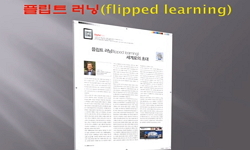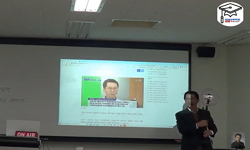The flipped learning approaches had drawn much attention from the research and practices communities. Despite this attention, how students learn in the flipped learning has been minimally explored. Focusing on this gap, this study investigated student...
http://chineseinput.net/에서 pinyin(병음)방식으로 중국어를 변환할 수 있습니다.
변환된 중국어를 복사하여 사용하시면 됩니다.
- 中文 을 입력하시려면 zhongwen을 입력하시고 space를누르시면됩니다.
- 北京 을 입력하시려면 beijing을 입력하시고 space를 누르시면 됩니다.
https://www.riss.kr/link?id=A103182439
- 저자
- 발행기관
- 학술지명
- 권호사항
-
발행연도
2017
-
작성언어
-
- 주제어
-
KDC
373
-
등재정보
KCI등재
-
자료형태
학술저널
- 발행기관 URL
-
수록면
347-370(24쪽)
-
KCI 피인용횟수
14
- DOI식별코드
- 제공처
-
0
상세조회 -
0
다운로드
부가정보
다국어 초록 (Multilingual Abstract)
Despite this attention, how students learn in the flipped learning has been minimally explored. Focusing on this gap, this study investigated students’ approach to learning in flipped learning. Students’ perception for this learning method was also scrutinized. For this purpose, the student-centered flipped learning was designed according to the nine design principles suggested by Kim et al. (2014). 34 premedical students enrolled in the interaction of human body and microorganism course participated in this study and the flipped learning was executed once a week for four weeks. To collect data, surveys for students’ perception on the flipped learning were conducted after the flipped learning and R-LPQ-2F to investigate approaches to learning and a course evaluation were also conducted before and after the flipped learning. Because students in student-centered flipped learning are required to learn by actively constructing new knowledge, it was expected that the medical students adopted deep approaches to learning. However, according to the results, there were no significant differences before and after the flipped learning in terms of students’ approaches to learning. The deep motivation, a sub-factor of the deep approach to learning, however, showed a significant increase, so it is thought that the flipped learning aroused intrinsic motivation and commitment to work. In addition, students recognized more highly interactive learning activities of the flipped learning than learning improvement in the flipped learning. They were also, in general, more satisfied with the flipped learning than the traditional teacher-oriented learning according to the course evaluation, but they showed significant higher preference toward the teacher-oriented learning than the flipped learning. The explanations for reasons why deep approaches to learning did not increase during the flipped learning were discussed.
The flipped learning approaches had drawn much attention from the research and practices communities.
Despite this attention, how students learn in the flipped learning has been minimally explored. Focusing on this gap, this study investigated students’ approach to learning in flipped learning. Students’ perception for this learning method was also scrutinized. For this purpose, the student-centered flipped learning was designed according to the nine design principles suggested by Kim et al. (2014). 34 premedical students enrolled in the interaction of human body and microorganism course participated in this study and the flipped learning was executed once a week for four weeks. To collect data, surveys for students’ perception on the flipped learning were conducted after the flipped learning and R-LPQ-2F to investigate approaches to learning and a course evaluation were also conducted before and after the flipped learning. Because students in student-centered flipped learning are required to learn by actively constructing new knowledge, it was expected that the medical students adopted deep approaches to learning. However, according to the results, there were no significant differences before and after the flipped learning in terms of students’ approaches to learning. The deep motivation, a sub-factor of the deep approach to learning, however, showed a significant increase, so it is thought that the flipped learning aroused intrinsic motivation and commitment to work. In addition, students recognized more highly interactive learning activities of the flipped learning than learning improvement in the flipped learning. They were also, in general, more satisfied with the flipped learning than the traditional teacher-oriented learning according to the course evaluation, but they showed significant higher preference toward the teacher-oriented learning than the flipped learning. The explanations for reasons why deep approaches to learning did not increase during the flipped learning were discussed.
참고문헌 (Reference)
1 이지연, "학습자 중심 플립드러닝(Flipped Learning) 수업의 적용 사례" 한국교육공학회 30 (30): 163-191, 2014
2 이희숙, "플립러닝의 학습효과 관련 요인 간의 구조적 관계 분석" 한국컴퓨터교육학회 19 (19): 87-100, 2016
3 서미옥, "플립드 러닝의 효과성에 대한 메타분석" 한국교육공학회 32 (32): 707-741, 2016
4 이동엽, "플립드 러닝(Flipped Learning) 교수학습 설계모형 탐구" 한국디지털정책학회 11 (11): 83-92, 2013
5 임경화, "실천공학 교수법 : 공학전공수업에서 플립드러닝(Flipped Learning)적용을 위한설계모형 탐색" 6 (6): 77-84, 2014
6 김남익, "대학에서의 거꾸로 학습(Flipped learning) 사례 설계 및 효과성 연구: 학습동기와 자아효능감을 중심으로" 한국교육공학회 30 (30): 467-492, 2014
7 한형종, "대학 역전학습 온·오프라인 연계 설계전략에 관한 연구" 한국교육공학회 31 (31): 1-38, 2015
8 Pierce, R., "Vodcasts and active-learning exercises in a"flipped classroom"model of a renal pharmacotherapy module" 76 (76): 1-5, 2012
9 Baeten, M., "Using student-centered learning environments to stimulate deep approaches to learning : Factors encouraging or discouraging their effectiveness" 5 (5): 243-260, 2010
10 Socha, A., "Using multidimensional scaling to improve functionality of the revised learning process questionnaire" 37 (37): 409-425, 2012
1 이지연, "학습자 중심 플립드러닝(Flipped Learning) 수업의 적용 사례" 한국교육공학회 30 (30): 163-191, 2014
2 이희숙, "플립러닝의 학습효과 관련 요인 간의 구조적 관계 분석" 한국컴퓨터교육학회 19 (19): 87-100, 2016
3 서미옥, "플립드 러닝의 효과성에 대한 메타분석" 한국교육공학회 32 (32): 707-741, 2016
4 이동엽, "플립드 러닝(Flipped Learning) 교수학습 설계모형 탐구" 한국디지털정책학회 11 (11): 83-92, 2013
5 임경화, "실천공학 교수법 : 공학전공수업에서 플립드러닝(Flipped Learning)적용을 위한설계모형 탐색" 6 (6): 77-84, 2014
6 김남익, "대학에서의 거꾸로 학습(Flipped learning) 사례 설계 및 효과성 연구: 학습동기와 자아효능감을 중심으로" 한국교육공학회 30 (30): 467-492, 2014
7 한형종, "대학 역전학습 온·오프라인 연계 설계전략에 관한 연구" 한국교육공학회 31 (31): 1-38, 2015
8 Pierce, R., "Vodcasts and active-learning exercises in a"flipped classroom"model of a renal pharmacotherapy module" 76 (76): 1-5, 2012
9 Baeten, M., "Using student-centered learning environments to stimulate deep approaches to learning : Factors encouraging or discouraging their effectiveness" 5 (5): 243-260, 2010
10 Socha, A., "Using multidimensional scaling to improve functionality of the revised learning process questionnaire" 37 (37): 409-425, 2012
11 Schmitt, N., "Uses and abuses of coefficient alpha" 8 (8): 350-353, 1996
12 Land, S. M., "Theoretical foundations of learning environments" Routledge 3-25, 2012
13 O'Flaherty, J., "The use of flipped classrooms in higher education : A scoping review" 25 : 85-95, 2015
14 Biggs, J., "The revised two-factor study process questionnaire : R-SPQ-2F" 71 (71): 133-149, 2001
15 McLaughlin, J. E., "The flipped classroom : A course redesign to foster learning and engagement in a health professions school" 89 (89): 236-243, 2014
16 Kim, M. K., "The experience of three flipped classrooms in an urban university : An exploration of design principles" 22 : 37-50, 2014
17 Marton, F., "The experience of learning" Scottish Academic Press 39-58, 1997
18 Kyndt, E., "The direct and indirect effect of motivation for learning on students' approaches to learning through the perceptions of workload and task complexity" 30 (30): 135-150, 2011
19 Biggs, J. B., "Study process questionnaire manual. Student approaches to learning and studying" Australian Council for Educational Research Ltd., Radford House 1987
20 Baeten, M., "Student-centered learning environments : An investigation into student teachers’ instructional preferences and approaches to learning" 19 (19): 43-62, 2016
21 Hannafin, M. J., "Student-centered learning and interactive multimedia : Status, Issues, and Implications" 68 (68): 94-99, 1997
22 Khanova, J., "Student experiences across multiple flipped courses in a single curriculum" 49 (49): 1038-1048, 2015
23 Chamorro-Premuzic, T., "Personality, intelligence and approaches to learning as predictors of academic performance" 44 (44): 1596-1603, 2008
24 Shea, P., "Learning presence : Towards a theory of self-efficacy, self-regulation, and the development of a communities of inquiry in online and blended learning environments" 55 (55): 1721-1731, 2010
25 Chin, C., "Learning in science : A comparison of deep and surface approaches" 37 (37): 109-138, 2000
26 Herrmann, K. J., "Investigating the relationships between approaches to learning, learner identities and academic achievement in higher education" 1-16, 2016
27 Strayer, J. F., "How learning in an inverted classroom influences cooperation, innovation and task orientation" 15 (15): 171-193, 2012
28 Al-Zahrani, A. M., "From passive to active : the impact of the flipped classroom through social learning platforms on higher education students' creative thinking" 46 (46): 1133-1148, 2015
29 Davies, R. S., "Flipping the classroom and instructional technology integration in a college-level information systems spreadsheet course" 61 (61): 563-580, 2013
30 Van Vliet, E. A., "Flipped-class pedagogy enhances student metacognition and collaborative-learning strategies in higher education but effect does not persist" 14 (14): 1-10, 2015
31 Toqeer, R., "Flipped classroom concept application to management and leadership course for maximizing the learning opportunities" 3 (3): 137-144, 2013
32 Bergmann, J., "Flip your classroom: Reach every student in every class every day" International Society for Technology in Education 2012
33 Kember, D., "Examining the multidimensionality of approaches to learning through the development of a revised version of the Learning Process Questionnaire" 74 (74): 261-279, 2004
34 Baeten, M., "Enhancing students’ approaches to learning : The added value of gradually implementing case-based learning" 28 (28): 315-336, 2013
35 Gilboy, M. B., "Enhancing student engagement using the flipped classroom" 47 (47): 109-114, 2015
36 Kong, S. C., "Developing information literacy and critical thinking skills through domain knowledge learning in digital classrooms : An experience of practicing flipped classroom strategy" 78 : 160-173, 2014
37 Garrison, D. R., "Critical thinking, cognitive presence, and computer conferencing in distance education" 15 (15): 7-23, 2001
38 Gijbels, D., "Constructivist learning environments and the (im) possibility to change students’ perceptions of assessment demands and approaches to learning" 36 (36): 431-, 2008
39 Mason, G. S., "Comparing the effectiveness of an inverted classroom to a traditional classroom in an upper-division engineering course" 56 (56): 430-435, 2013
40 Zeegers, P., "Approaches to learning in science : A longitudinal study" 71 (71): 115-132, 2001
41 Mattick, K., "Approaches to learning and studying in medical students : Validation of a revised inventory and its relation to student characteristics and performance" 38 (38): 535-543, 2004
42 Heeseung Choi, "Applying the Flipped Learning Model to an English-Medium Nursing Course" 한국간호과학회 45 (45): 939-948, 2015
43 Jeffries, W. B., "An introduction to medical teaching" Springer 41-55, 2014
동일학술지(권/호) 다른 논문
-
공공연구기관 종사자의 개인적 배경, 셀프리더십, 직무환경요인이 창의적 행동에 미치는 영향
- 한국교육방법학회
- 김믿음(Mid-eum Kim)
- 2017
- KCI등재
-
성장혼합모형을 적용한 초기 청소년의 공동체의식 유형분류 및 영향요인 검증
- 한국교육방법학회
- 이정민(Lee, Jungmin)
- 2017
- KCI등재
-
교원양성기관에서의 수업설계 교육을 통해 나타난 중등 예비교사의 수업설계 특징 탐색
- 한국교육방법학회
- 정한호(Hanho Jeong)
- 2017
- KCI등재
-
확인적 요인분석과 구조방정식모형분석에서 다차원 척도에 대한 다양한 문항묶음방법 적용연구
- 한국교육방법학회
- 오숙영(Oh, Sook Young)
- 2017
- KCI등재
분석정보
인용정보 인용지수 설명보기
학술지 이력
| 연월일 | 이력구분 | 이력상세 | 등재구분 |
|---|---|---|---|
| 2026 | 평가예정 | 재인증평가 신청대상 (재인증) | |
| 2020-01-01 | 평가 | 등재학술지 유지 (재인증) |  |
| 2017-01-01 | 평가 | 등재학술지 유지 (계속평가) |  |
| 2013-01-01 | 평가 | 등재 1차 FAIL (등재유지) |  |
| 2010-01-01 | 평가 | 등재학술지 유지 (등재유지) |  |
| 2007-01-01 | 평가 | 등재학술지 선정 (등재후보2차) |  |
| 2006-01-01 | 평가 | 등재후보 1차 PASS (등재후보1차) |  |
| 2005-06-17 | 학술지등록 | 한글명 : 교육방법연구외국어명 : The Korean Journal of Educational Methodology Studies |  |
| 2004-01-01 | 평가 | 등재후보학술지 선정 (신규평가) |  |
학술지 인용정보
| 기준연도 | WOS-KCI 통합IF(2년) | KCIF(2년) | KCIF(3년) |
|---|---|---|---|
| 2016 | 1.94 | 1.94 | 2.08 |
| KCIF(4년) | KCIF(5년) | 중심성지수(3년) | 즉시성지수 |
| 2.23 | 2.35 | 2.393 | 0.91 |




 KCI
KCI 스콜라
스콜라






